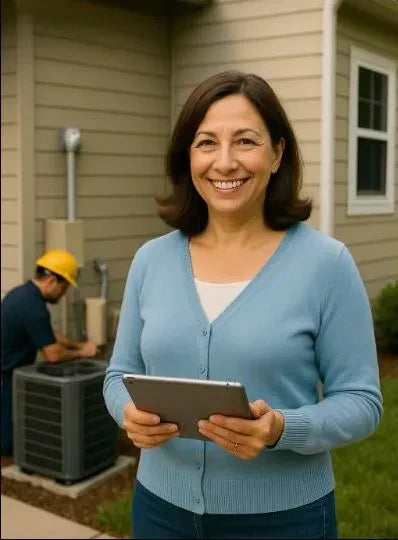Future of Heating: Where R32 Gas Furnaces Fit
Heating technology is changing fast. From new refrigerants like R32 to hybrid heat pump setups and ambitious decarbonization goals, the HVAC industry is in the middle of a transformation. For homeowners, that raises a big question: Where do gas furnaces fit into this future?
The short answer: they’re evolving, not disappearing. In fact, modern R32 Gas Furnaces are central to bridging today’s heating needs with tomorrow’s sustainability goals. They’re cleaner, more efficient, and often paired with electric solutions in dual-fuel systems that give you the best of both worlds.
In this guide, we’ll explore trends, technology, and the next 5–10 years of heating, showing exactly how gas furnaces will continue to play a role.
1 | The Changing Landscape of Heating
The HVAC industry is being reshaped by three key forces:
-
Decarbonization: Governments are pushing for lower carbon emissions.
-
Efficiency Standards: New rules like SEER2 and AFUE upgrades are raising the bar.
-
Refrigerant Transitions: R410A is being phased out; R32 is becoming the new global standard.
According to the International Energy Agency, heating and cooling account for nearly half of global energy consumption (IEA). That’s why efficiency and refrigerant choices matter more than ever.
2 | The Role of R32 in the Future
Why is R32 such a big deal? Because it solves a major environmental challenge.
-
Global Warming Potential (GWP): R32 = ~675, compared to R410A’s 2,088 (EPA).
-
Efficiency: Requires 20–30% less refrigerant volume.
-
Safety: Classified A2L (mildly flammable) but widely used safely worldwide.
While gas furnaces themselves don’t use refrigerant, their compatibility with R32-based cooling systems ensures your HVAC investment is future-ready.
3 | Hybrid & Dual-Fuel Systems: The New Normal
The future isn’t about choosing between gas and electric—it’s about combining them.
-
Dual-Fuel Setup: A heat pump provides efficient heating in mild weather. When temperatures drop too low, the gas furnace kicks in for reliable warmth.
-
Why It Works: Reduces fossil fuel use, lowers costs, and ensures comfort in all climates.
-
Future-Proof: Compatible with upcoming refrigerants like R32, so you won’t be forced into early replacements.
4 | Decarbonization & Gas Furnaces
Some people assume decarbonization means the end of gas furnaces. The truth is more nuanced.
-
In cold climates, gas furnaces are still the most reliable option.
-
New efficiency standards (95%+ AFUE) make them much cleaner than older models.
-
When paired with renewable electricity in hybrid systems, gas usage is minimized.
According to the U.S. DOE, upgrading from an 80% to a 95% AFUE furnace reduces emissions by 20% or more (Energy.gov).
5 | The 5–10 Year Outlook
Here’s what homeowners can expect by 2035:
-
Refrigerant Shift: R32 and other low-GWP refrigerants become the standard.
-
Hybrid Systems: Dual-fuel systems dominate, balancing efficiency and reliability.
-
Stricter Codes: Building regulations may require higher AFUE ratings.
-
Smart Controls: Thermostats and AI-driven systems optimize comfort and savings.
-
Carbon Goals: States may incentivize hybrid systems over single-fuel setups.
6 | Myths About the Future of Gas Furnaces
Myth 1: Gas furnaces will be banned everywhere.
Fact: Some regions may push for all-electric, but cold-climate areas will continue to rely on gas furnaces in dual-fuel setups.
Myth 2: R32 isn’t safe enough for long-term use.
Fact: R32 is already used in millions of systems worldwide with excellent safety records.
Myth 3: Electric heat pumps alone will replace everything.
Fact: In extreme cold, heat pumps lose efficiency—gas furnaces still play a backup role.
7 | Case Study: The Hybrid Home
Location: Chicago, IL
Setup: Dual-fuel system with R32-compatible gas furnace + heat pump
Result:
-
30% lower annual heating bills
-
Reliable heat during sub-zero winters
-
Qualified for $1,500 in rebates and credits
This model—hybrid-ready, efficient, and compliant—is a glimpse of the future of heating.
8 | Renewable Energy Integration
The future also includes more renewable integration:
-
Solar panels powering heat pumps in mild weather
-
Gas furnaces as backup during peak demand or extreme cold
-
Smart grid connections balancing loads
According to ASHRAE, smart integration of HVAC with renewables can cut carbon emissions by up to 40% in residential homes (ASHRAE).
9 | FAQs
Q: Will I have to replace my current furnace soon?
A: Not if it’s efficient and in good condition. But if you plan to add cooling, choose an R32-compatible furnace now.
Q: Is an R32 Gas Furnace more expensive?
A: Slightly up front, but savings, rebates, and future compliance make it cheaper long-term.
Q: Do gas furnaces still qualify for rebates?
A: Yes—many qualify for federal and state incentives if 95%+ AFUE.
Q: Will gas furnaces still be available in 10 years?
A: Absolutely—especially in hybrid and dual-fuel systems.
10 | Final Take
The heating world is changing, but gas furnaces aren’t going away—they’re adapting.
The future is hybrid: gas furnaces for reliability, paired with efficient R32-powered systems for sustainability. Together, they create comfort, savings, and resilience.
So when you think about the next 5–10 years, don’t think of it as choosing gas or electric. Think of it as building a smart, flexible system that gives you both. That’s where R32 gas furnaces fit.







